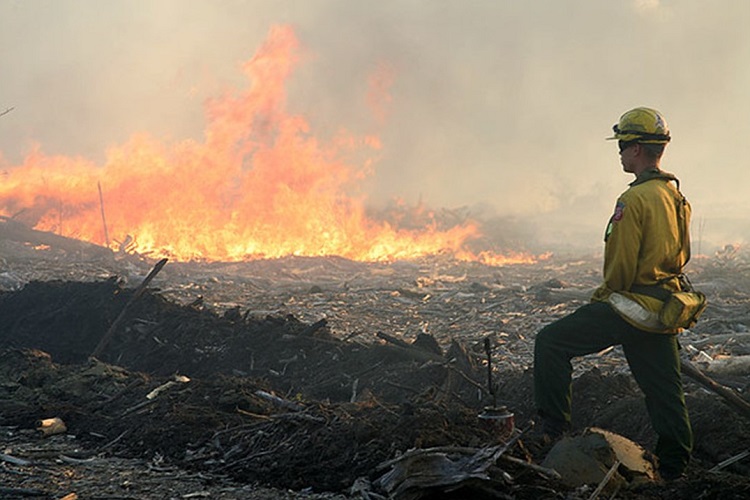

Photo by Mike Legeros.
By David Cain
The word “safety” is misunderstood in the fire service. First, there is nothing SAFE about being a firefighter or a medic. A firefighter’s job, whether paid or volunteer, is not safe; the inherent risks of firefighting are too great to think that we can be safe. According to Merriam-Webster, being safe is freedom from harm or danger. The greater question is RISK. Just like safety, risk can be understood and managed to a degree.
The definition of risk is the integration of probability/consequences; this is a whole lot different than safety or being safe. We can take steps to lower our risk and play the odds that training, common sense, and experience will lessen the probability of a bad outcome. Much of what happens in a firefighting career can be beyond our control. We can do all the right things and still get injured or even killed because of no fault of our own.
However, the facts can work against us when it comes to protecting ourselves. Since my retirement, I have observed and studied trends and patterns in the fire service. In many cases, the “bad” outcomes have a direct correlation to poor choices.
One simple example is injuries sustained from not wearing a seat belt. I just read a story about a firefighter who died in an accident from excessive speed and not wearing a seat belt. Not only was the crew member killed but a subsequent report found that the driver had no idea how fast he was going because the speedometer was not working. This is crazy and not necessary. This story of noncompliance is very common.
Another hot topic I hear and read about is work schedules. Do we work these crazy, long hours for the wrong reasons? In some jurisdictions, drive time, family time, off-duty work, and overtime outweigh the sensibility of working reasonable hours. Much of this issue depends on the workload within a department. Studies have shown that the fatigue factor and lack of sleep can—over time—cause all kinds of mental and physical problems. In my own experience, I always took a nap on my days off, but you cannot make up for those lost hours of sleep.
Other concerns that we can absolutely control are expectations that we, as firefighters, can do it all. It has become clear that the fire service is the “catch all” department. Can we really do it all? I think not.
The expectation is that we run 911 calls and many other nonemergent calls for service. We fight fires (structural and wildland) and we are tasked with hazmat, swift water, dive rescue, trench rescue, high- and low-angle rescue, auto extrication, fire inspections, public education, on-call status at planned events, truck checks, inventory checks, running power tools, cleaning the stations, training, and the never-ending EMS calls. This expectation is crazy and unrealistic.
Risk Management Practices in the Fire Service
In January 2018, the United States Fire Administration came out with their report. I read the document in its entirety. The key is the term “risk.” Following are my takeaways from this report.
First, we attempt to minimize detrimental effects. We cannot eliminate them. If the fire service is unable to perform its fire control mission, the community’s fire/risk balance could be compromised. Fire leaders are responsible for ensuring that their organizations are ready and able to perform their mission and meet the community’s expectations.
Next, agencies are spending money to compensate for circumstances that should have been avoided. For example, poor maintenance of fire apparatus is inexcusable. Citizens that fund the purchase of million-dollar trucks deserve proper care of their investment. The iconic symbol of a fire engine is always seen as clean and ready to go. The truth, based on documented reports, is that many fire apparatuses are not fit to be driven. The equipment that provides the means to do the work must be of paramount importance. Properly maintained equipment helps us balance the risks.
The proactive mentality vs. the reactive actions can and will reduce undesirable outcomes. If equipment doesn’t run, we can’t respond properly, leaving departments and the communities they serve in great peril.
The three primary control measures for risk managers are the following:
- Administration.
- Engineering.
- Personal protection.
Ensuring that these three things are done properly is the chief’s responsibility. The chief is the risk manager and must protect the public assets of personnel, facilities, and equipment.
The tough decisions that a chief officer must make include the money spent and the desirable outcome. This includes replacing lost, stolen, or poorly maintained equipment.
Finally, operational risk is the inherent risk of response. We increase risk through a lack of good training, poorly maintained equipment, and firefighters who do not come prepared for the shift. We count on each other and we count on our equipment. Managing risk for others is the fire department’s mission. If we don’t attempt to manage risk, we are leaving our fate to chance.
David Cain is a deputy chief (ret.) with the Boulder (CO) Fire Department, where he served for 34 years. He works as a consultant for PSTrax.com, a technology service that helps fire departments across the country automate their apparatus, equipment, and inventory checks.

